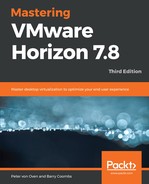VMware Tools enhances the usability of the virtual desktop machine. It installs VMware-specific device drivers that allow it to run as a virtual desktop machine, replacing the physical hardware equivalents. The installation of VMware Tools is initiated from the vSphere Client:
- From the Windows 7 Gold Image virtual machine and its Summary tab, click on Install VMware Tools (1), as follows:

- Initiating the installation from the vSphere Web Client effectively mounts the VMware Tools installation media as a virtual CD drive on the virtual desktop machine. You will see the following Install VMware Tools dialog box pop up, as shown in the following screenshot:

- Click the MOUNT button (2) to mount the VMware Tools installation media, and then switch back to the console of the virtual desktop machine.
- You will now see the AutoPlay dialog box showing that the VMware Tools DVD drive has been mounted and that the installation program is available to launch, as shown in the following screenshot:

- Click Run setup64.exe (3) to launch the VMware Tools installer.
- If you see the User Account Control box pop up warning you about making changes to the computer, ignore it by clicking on the Yes button.
- You will now see the Welcome to the installation wizard for VMware Tools dialog box.
- Click the Next > button to continue the installation. You will now see the Choose Setup Type dialog box, as shown in the following screenshot:

- Click the radio button for Custom (4), and then click the Next > button to continue. You can also choose the Typical option, which installs a standard set of drivers; however, for the purposes of this book, and to describe all the available options, we are going to look at a custom install. You will now see the Custom setup dialog box, as shown in the following screenshot:

- VMware Tools will install the following VMware device drivers, depending on whether they are selected. By default, all are selected, excluding the VMCI Drivers. The drivers and their functions are described here:
- Paravirtual SCSI: This is for PVSCSI adapters to enhance the performance of virtualized applications.
- Memory Control Driver: This allows memory management of the virtual desktop machine when running on an ESXi host.
- PS2/USB Mouse Driver: This virtual mouse driver improves the performance of the mouse in a virtual desktop machine.
- SVGA Driver: This enables 32-bit displays, high resolution, and faster graphics performance. It installs a virtual SVGA driver that replaces the standard VGA driver. On Windows Vista and later versions, the VMware SVGA 3D (Microsoft – WDDM) driver is also installed, adding support for Windows Aero.
- Audio Driver: This is required for all 64-bit guest operating systems, since it enables sound capabilities.
- VMXNET3 NIC Driver: This improves network performance and is recommended for virtual desktop machines.
- Volume Shadow Copy Services: This allows you to take backup copies or snapshots of the virtual desktop machine.
- VMCI Driver: This allows faster communication between virtual machines.
- NSX File Introspection Driver: This installs the agent so that you can use antivirus offload scanning.
- The other options in this dialog box are for Browse..., which allows you to change where VMware tools are installed, and Disk Usage, to check the disk space requirements so that you can check the amount of disk space that VMware Tools will need to install your chosen options.
- Click the Next > button to continue. You will now see the Ready to install VMware Tools dialog box. Click the Install button to start the install process.
- Once completed, you will see the Completed the VMware Tools Setup Wizard dialog box. Click on the Finish button to complete the installation process.
- You will now be prompted to restart the virtual desktop machine so that you can start the VMware Tools services. From the dialog box, click the Yes button to reboot.
- Once the virtual desktop machine has restarted, check that the VMware Tools services are up and running by clicking on the taskbar and checking for the VM icon (5), as shown in the following screenshot:

You can also launch the Services console from the virtual desktop machine and check that the service is running from there, as shown in the following screenshot:

You have successfully installed VMware Tools. The next step is to install any core applications that you want to include as part of the parent image.
